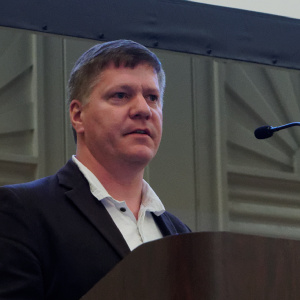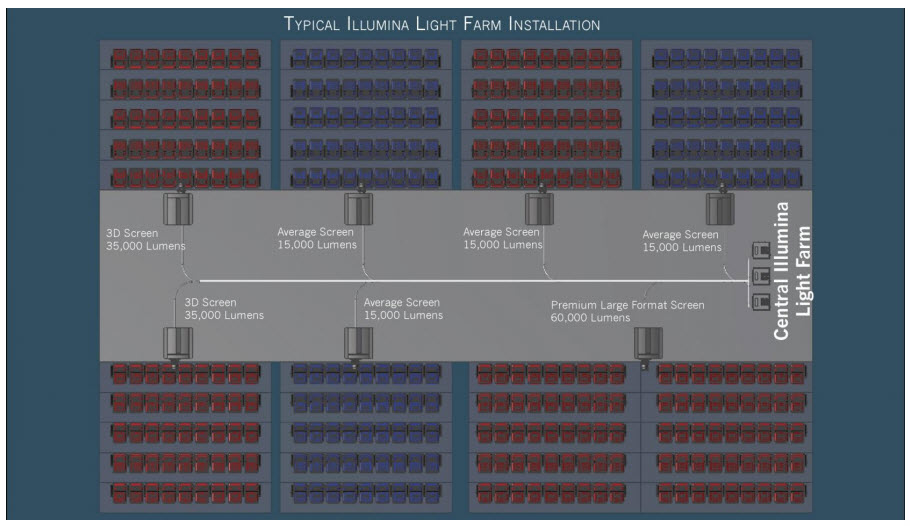
Walter Burgess is from Power Technology which develops laser light sources for really bright projectors, in the 50K-60K lumens range. The company won a US government project to research the removal of speckle from lasers and learned a lot in the process. The firm has been showing its laser sources with projectors from others including NEC. It calls its solutions ‘light farms’
The company uses RGB lasers to illuminate multiple projectors. People in A/V are looking to reduce their costs, Burgess said. A Xenon bulb may cost $1000 and last just 1,000 hours. Power is also expensive. Lasers can reduce the cost of power – a significant factor in a multiplex. It’s not the right solution for every application though, he said; it only really works with three device solutions.
 PT showed how its laser farm can run multiple projectors of varying brightness.
PT showed how its laser farm can run multiple projectors of varying brightness.
Burgess showed a diagram of a seven screen multiplex with different projectors of different brightness. e,g, one 60K, two 35K and four 15K. He thinks that laser phosphor (LP) is not a ‘real’ laser – it doesn’t get the high colour quality needed for cinema, in his view. LP will not drive the consumer back to the cinema and ‘off the couch’, he believes.
There are seven companies active in laser projection, but they have different strategies. There are two groups in terms of light sources – one group uses fibre cables to deliver the light, while others have direct illumination. Power Technology, Christie, NEC, Cinemeccanica and IPG are in the fibre group, while Sony and Barco are direct.
What are the pros & cons? Scalability is an issue. With fibre you can change how much light you want.
Weight can be an issue especially for ceiling-hung or with rigging. Fibre allows you to move most of the weight away from the head.
Noise can also be moved away. Fans can be moved to another room. Important in worship and concerts.
Redundancy – e.g. Christie has 12 light sources – if one fails, you still have 11.
There are myths about illumination. One is that direct is more efficient. It’s true that by putting laser into a fibre, you lose light, but good engineering means only <10%. However, direct illumination needs a lot of optics to couple from the lasers to the display – each set of optics loses energy, so soon you are as low as fibre. Some lasers may have up to 500 laser beams that need to be combined and that takes some technology. Fibre is cheap – the cost of some fibre is around 85 cents per meter and it’s really not a significant cost (although joining it might be, others commented).
Projectors with xenon bulbs are already probably running at 240V, Burgess said. Power Technology can use 110V, but prefers to use 240V if available. A central location is not always the right location as there is some attenuation in fibre, so distance might be an issue. Blue is the worst for this, but 10m loss is around 1.25% and blue light is also the cheapest to produce, so it’s not so serious, in his view. To get D65 white point, you also use relatively little blue, but a lot of green.
There was a question about bending the fibres, for example in a motion application such as a simulator. Burgess said that flexing does, eventually, kill the fibre, but it is not so expensive and is replaceable. 100K to 300K lumens spread over multiple projectors is the range for a farm.

